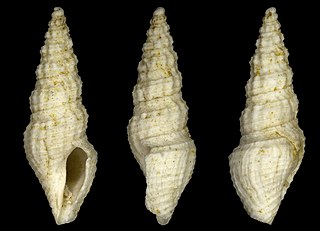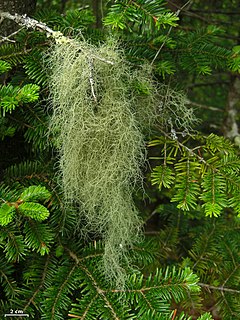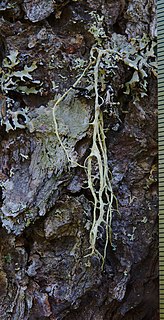
Evernia prunastri, also known as oakmoss, is a species of lichen. It can be found in many mountainous temperate forests throughout the Northern Hemisphere. Oakmoss grows primarily on the trunk and branches of oak trees, but is also commonly found on the bark of other deciduous trees and conifers such as fir and pine. The thalli of oakmoss are short and bushy, and grow together on bark to form large clumps. Oakmoss thallus is flat and strap-like. They are also highly branched, resembling the form of antlers. The colour of oakmoss ranges from green to a greenish-white when dry, and dark olive-green to yellow-green when wet. The texture of the thalli is rough when dry and rubbery when wet. It is used extensively in modern perfumery.

The Parmeliaceae is a large and diverse family of Lecanoromycetes. With over 2700 species in 71 genera, it is the largest family of lichen-forming fungi. The most speciose genera in the family are the well-known groups: Xanthoparmelia, Usnea, Parmotrema, and Hypotrachyna.

Usnic acid is a naturally occurring dibenzofuran derivative found in several lichen species with the formula C18H16O7. It was first isolated by German scientist W. Knop in 1844 and first synthesized between 1933-1937 by Curd and Robertson. Usnic acid was identified in many genera of lichens including Usnea, Cladonia, Hypotrachyna, Lecanora, Ramalina, Evernia, Parmelia and Alectoria. Although it is generally believed that usnic acid is exclusively restricted to lichens, in a few unconfirmed isolated cases the compound was found in kombucha tea and non-lichenized ascomycetes.

Evernia is a genus of bushy lichens in the family Parmeliaceae.

In enzymology, an agmatinase (EC 3.5.3.11) is an enzyme that catalyzes the chemical reaction

Masonhalea is a genus of two species of lichenized fungi in the family Parmeliaceae.

Olivetol, also known as 5-pentylresorcinol or 5-pentyl-1,3-benzenediol, is an organic compound found in certain species of lichen; it is also a precursor in various syntheses of tetrahydrocannabinol.
Harvey and Clarke was an American architectural firm formed by Henry Stephen Harvey and L. Philips Clarke in West Palm Beach, Florida, in 1921. The firm was active in South Florida for only a few years, but in that time designed a number of distinctive homes, apartments, churches, and commercial buildings. Harvey was a member of the West Palm Beach Planning Commission. Firm member Gustav Maass designed several railroad stations, and became a noted South Florida architect in his own right.

Atraric acid is a naturally occurring phenolic compound and ester with the IUPAC name methyl 2,4-dihydroxy-3,6-dimethylbenzoate and molecular formula C10H12O4. It occurs in the root-bark of Pygeum africanum and Evernia prunastri (Oakmoss). There is evidence to suggest that it has antiandrogenic activity in humans and its use in treatment of benign prostate hyperplasia, prostate cancer, and spinal and bulbar muscular atrophy has been investigated.

Holy Trinity Episcopal Church is a historic building at 211 Trinity Place in West Palm Beach. It was deemed eligible for listing on the National Register of Historic Places on December 31, 1998, but was not listed due to objections from the property owner.

West Palm Beach station is an inter-city rail station in West Palm Beach, Florida. It is served by Brightline, connecting Miami and Orlando International Airport. The station is located in downtown West Palm Beach, on Evernia Street between Rosemary Avenue and Quadrille Boulevard. This is about half a mile east of Amtrak and Tri-Rail's West Palm Beach station and half a mile south of the older Florida East Coast Railway station that operated on the same tracks in the first half of the 1900s, next to where Quadrille Boulevard turns south after crossing the Flagler Memorial Bridge.

Carolyn Wilson Harris was vice president of the Sullivant Moss Society during 1904–1905 and charge of the Lichen Department from 1901–1905. She also wrote many articles on various lichen genera and species. She was known for being an indefatigable worker, and did much to popularize the study of lichens; her help was always given freely and cheerfully to those who applied to her for assistance in their studies.

Crassispira nana is an extinct species of sea snail, a marine gastropod mollusk in the family Pseudomelatomidae, the turrids and allies.

Usnea trichodea, commonly known as bony beard lichen, is a pale straw-colored fruticose lichen with a pendant growth form. It grows on trees and is native to eastern North America.
Evernia illyrica is a species of lichen belonging to the family Parmeliaceae.

Evernia divaricata is a species of lichen belonging to the family Parmeliaceae.

Evernia esorediosa is a species of lichen in the family Parmeliaceae. It has no soralia, but many ascocarps.
Sten Gustaf Edvard Ahlner was a Swedish lichenologist.














